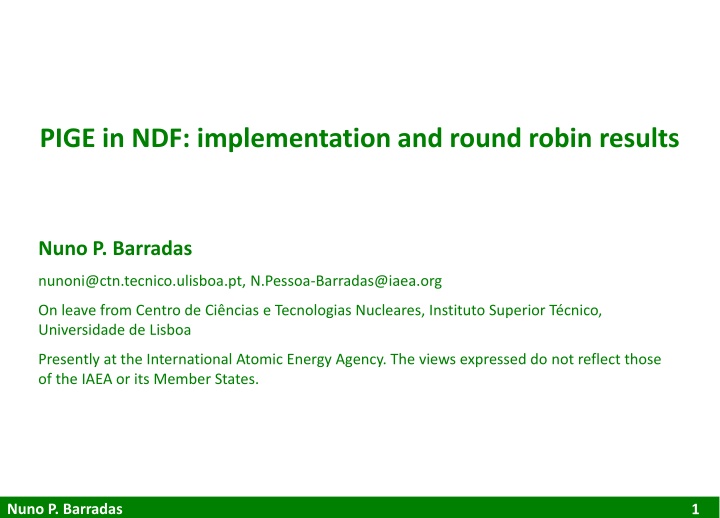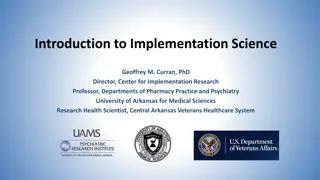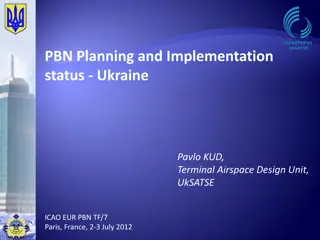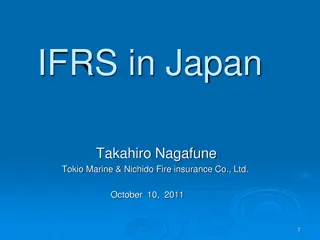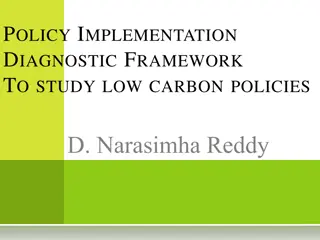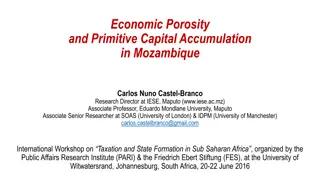Principles and Implementation of PIGE in NDF by Nuno P. Barradas
Overview of the basic principles and implementation details of Particle Induced Gamma-ray Emission (PIGE) calculation using NDF code, including handling of stopping power, cross-sections, and sub-layers. The process involves simulating incident energy on each layer, calculating cross-sections, and integrating yield over all layers. Implementation of stopping power sources and considerations for energy loss and straggling effects in multilayered samples are discussed by Nuno P. Barradas.
Download Presentation

Please find below an Image/Link to download the presentation.
The content on the website is provided AS IS for your information and personal use only. It may not be sold, licensed, or shared on other websites without obtaining consent from the author.If you encounter any issues during the download, it is possible that the publisher has removed the file from their server.
You are allowed to download the files provided on this website for personal or commercial use, subject to the condition that they are used lawfully. All files are the property of their respective owners.
The content on the website is provided AS IS for your information and personal use only. It may not be sold, licensed, or shared on other websites without obtaining consent from the author.
E N D
Presentation Transcript
PIGE in NDF: implementation and round robin results Nuno P. Barradas nunoni@ctn.tecnico.ulisboa.pt, N.Pessoa-Barradas@iaea.org On leave from Centro de Ci ncias e Tecnologias Nucleares, Instituto Superior T cnico, Universidade de Lisboa Presently at the International Atomic Energy Agency. The views expressed do not reflect those of the IAEA or its Member States. Nuno P. Barradas 1
Overview Basic principles of PIGE calculation from first principles Implementation Handling of stopping power Handling of cross sections Definition of sub-layers NDF code Basic data Language etc Input and output IAEA intercomparison of PIGE codes Some results Final comments Nuno P. Barradas 2
Basic principles of PIGE simulation Divide sample into sub-layers Calculate incident energy on each layer: energy loss Calculate cross section on each layer: from tabulated cross section Assume no absorption of rays Integrate yield over all layers Points to consider: In a sub-layer, do we take the cross section on top or bottom of layer, or something else (integrate over sub-layer)? In a sub-layer, do we calculate energy loss with the stopping power at top of the layer, or something else (integrate over sub-layer)? Straggling can have strong effect in multilayered samples Nuno P. Barradas 3
Implementation: Stopping power (1) In NDF, any combination of sources of stopping powers can be used: Tabulated (i.e. experimental ): For elements For molecules (e.g. SiO2) Calculated: ZBL95 ZBL2000 SRIM: used in this case MSTAR SRIM: called at first use of a given ion in a given element in a given energy range Produces a file with 5000 stopping values calculated for equally spaced energy values If same ion/element/energy range needed again, and version of SRIM did not change, then file is read Linear interpolation made on tabulated values Nuno P. Barradas 4
Implementation: Stopping power (2) In a sub-layer: If energy loss in sub-layer smaller than the energy step in internal table, take the stopping power at top of the layer Otherwise integrate over sub-layer (3- or 5-point Simpson) Because stopping power changes slowly, this is accurate enough, as long as sub- layer not enormously thick Nuno P. Barradas 5
Implementation: Energy spread In-built models: Bohr, Chu, Tsch l r WDEPTH: used to calculate Doppler (0.1 keV) Doppler added in quadrature with FWHM Energy spread shape: Gaussian or gamma function (inspiration from Matej s paper on roughness) Options taken Gaussian : Bohr straggling, no Tsch l r, Doppler=0.1 keV, Gaussian Full : Chu+Tsch l r, Doppler=0.1 keV, gamma function Nuno P. Barradas 6
Implementation: Cross section (1) Three issues: Initial yield is user input Integration within each sub-layer essential whenever cross section changes faster than sub-layer energy width Convolution with energy spread essential in layered targets, where (real) layer energy width comparable to resonance width NDF integrates experimental cross sections over each sub-layer Nuno P. Barradas 7
Implementation: Cross section (2) Three issues: Initial yield is user input Integration within each sub-layer essential whenever cross section changes faster than sub-layer energy width Convolution with energy spread essential in layered targets, where (real) layer energy width comparable to resonance width Example for p-RBS: 1 m Mylar film under a 4.2 m Ni film 2000 data with effect without effect Yield (counts/ C msr keV ) 1500 1000 500 0 2000 2050 2100 2150 E0 (keV) NDF integrates cross section over energy spread Yield can change dramatically for thin layers In bulk targets, shape can change as well Nuno P. Barradas 8
Implementation: Definition of layers Usually following method for sub-division of layers is used: User defines internal layer thickness for 1.5 MeV 4He RBS (default: 50x1015 at/cm2) NDF scales to actual problem by scaling to stopping powers Maximum and minimum imposed. In this case, not needed Whenever cross section is not Rutherford (i.e. RBS and ERDA), and a file is input: Autolayer: Create further sub-layers, by creating extra division points at all energies where a cross section value is given In present case, little difference towards simple sub-division Nuno P. Barradas 9
Code: Basic data Navogadro=6.022140857e23 pi=3.141592654 e_charge=1.6021766208e-19 e0_permitivity=8.854187817e-12 following are in kg p_mass=1.672621898e-27 n_mass=1.674927471e-27 e_mass=9.10938356e-31 following is in amu e_mass_u=5.485799090e-4 c c Isotopic masses and natural abundances: 27Al 100%. NDF uses single precision (compil: extended precision) except in critical routines Nuno P. Barradas 10
Code: Language etc NDF is written in Fortran (insert version here: whatever is available in compiler): Compiler: Digital/Microsoft Possibly some very few compiler extensions are used; none on actual calculations No libraries used PIXE routine is in C, compiled as object with Fortran/C interface Described in Status of IBA data analysis and simulation software, E. Rauhala et al., Nucl. Instrum. Methods Phys. Res. B244 (2006) 436-456 Took part in International Atomic Energy Agency intercomparison of Ion Beam Analysis software, N.P. Barradas et al., Nucl. Instrum. Methods Phys. Res. B262 (2007) 281-303. Took part in International Atomic Energy Agency intercomparison of Ion Beam Analysis software, N.P. Barradas et al., Nucl. Instrum. Methods Phys. Res. B 468 (2020) 37-47 Proprietary, commercial, general purpose, in active (currently slow) development PIGE routine partly open source, input data including stopping power and cross sections come from NDF Nuno P. Barradas 11
Code: Input and output Input (basic data) (NDF stuff: license, config file, etc) Experimental data: table of Energy/Yield Calculation is made independently, consecutively, for each energy in table Depth profile to be calculated Experimental conditions Calculation options Output Calculation: table with Energy/Experimental yield/Calculated yield Result file with all calculations made, options, depth profile, etc (assorted files with extra information, including intermediary calculations etc) Nuno P. Barradas 12
Intercomparison: Autolayer Calculations for automatic further subdivision of layers at each energy given in the cross section file (autolayer) Up to 1 part in 100000 difference. Autolayer on more stable: hence reported values used autolayer on 36.8876 Calc 1, 0 keV, Gaussian Calc 1, 0 keV, full 36.8875 36.8875 36.8874 Yield (counts) Yield (counts) 36.8873 36.8874 36.8872 36.8873 Autolayer off Autolayer on Autolayer off Autolayer on 36.8871 36.8872 1680 1690 1700 Energy (keV) 1710 1720 1730 1680 1690 1700 Energy (keV) 1710 1720 1730 Nuno P. Barradas 13
Intercomparison: NDF vs SPACES, calc 2 (1) Used apps.automeris.io/wpd to extract numerical data. Not fully accurate (depends on manual input of 2 x and 2 y reference data points) Normalized SPACES to NDF 0.26 Calc 2, 0 and 1 keV, full SPACES from https://apps.automeris.io 0.24 0.22 0.20 0.18 0.16 Yield (counts) 0.14 0.12 It seems like NDF fairly reproduces SPACES, with a shift in the Lewis peak for 1 keV But let s calculate with 50 eV steps 0.10 NDF 0 keV SPACES 0 keV NDF 1 keV SPACES 1 keV 0.08 0.06 0.04 0.02 0.00 1682 1683 1684 1685 1686 1687 1688 Energy (keV) Nuno P. Barradas 14
Intercomparison: NDF vs SPACES, calc 2 (2) NDF overestimates the Lewis peak: gamma function not realistic at very small energy losses 0.40 Calc 2, 0 and 1 keV, full SPACES from https://apps.automeris.io 0.35 0.30 0.25 Yield (counts) 0.20 0.15 NDF 0 keV SPACES 0 keV NDF 1 keV SPACES 1 keV 0.10 0.05 0.00 1681 1682 1683 1684 1685 1686 1687 1688 1689 1690 Energy (keV) Nuno P. Barradas 15
Intercomparison: NDF vs SPACES, calc 2 (3) Not a new result! This limitation in the NDF model is already known since 2010 C: stronger straggling, lower stopping, hence much stronger Lewis effect Nuno P. Barradas 16
Intercomparison: calc 7 (1) Ex 7 E=0 Ex 7 Full E=0 6 6 5.5 5.5 5 5 4.5 4.5 yield yield 4 4 3.5 3.5 3 3 2.5 2.5 2 2 1995 2000 2005 2010 2015 beam energy 2020 2025 2030 2035 2040 2045 1995 2000 2005 2010 beam energy (keV) 2015 2020 2025 2030 2035 2040 2045 ERYA NDF SMNRA ERYA NDF SMNRA All three codes agree extremely well for Gaussian straggling NDF significantly different for full straggling: Curves for ERYA-Prof and SIMNRA are nearly identical with Gaussian and full straggling. This is unexpected since Gaussian was defined as Bohr, no Tsch l r , while Full was best model (for NDF, Chu+Tsch l r+Doppler) Nuno P. Barradas 17
Intercomparison: calc 7 (2) First step: look at, for e.g. 2000 and 2040 keV beam energy: Energy before scattering FWHM for Gaussian (i.e. Bohr) and full (i.e. Chu+Tsch l r) (Gaussian vs. gamma does not play a role, results are nearly identical) 46 2000, Gauss 2000, Full 2040, Gauss 2040, Full Full 1730 2040 44 1720 2000, Gauss 2000, Full 2040, Gauss 2040, Full 1710 42 FWHM (keV) Escatter (keV) 1700 40 1690 38 1680 2000 1670 36 Gaussian 1660 34 1650 56000 57000 58000 59000 60000 61000 62000 63000 56000 57000 58000 59000 60000 61000 62000 63000 Depth Depth Nuno P. Barradas 18
Intercomparison: calc 7 (3) 1.5 5.0 ERYA NDF SIMNRA NDF-Gaussian 4.5 4.0 Energy range in Al layer +FWHM/2(Bohr) Sigma (mbarn) 1.0 3.5 E0 = 2040 keV Yield +FWHM/2(full) 3.0 2.5 2.0 0.5 E0 = 2000 keV 2000 2010 2020 2030 2040 Beam energy (keV) 0.0 1630 1640 1650 1660 1670 1680 1690 1700 1710 1720 1730 1740 1750 Energy (keV) Nuno P. Barradas 19
Intercomparison: calc 7 (4) 1.5 5.0 ERYA NDF SIMNRA NDF-Gaussian 4.5 4.0 3.5 Sigma (mbarn) 1.0 E0 = 2040 keV Yield 3.0 2.5 2.0 0.5 E0 = 2000 keV 2000 2010 2020 2030 2040 Beam energy (keV) 0.0 1630 1640 1650 1660 1670 1680 1690 1700 1710 1720 1730 1740 1750 Energy (keV) Nuno P. Barradas 20
Intercomparison: calc 7 (5) 1.5 1.5 5.0 ERYA NDF SIMNRA NDF-Gaussian 4.5 4.0 Sigma (mbarn) 1.0 1.0 Sigma (mbarn) E0 = 2040 keV E0 = 2040 keV 3.5 Yield 3.0 2.5 2.0 0.5 0.5 E0 = 2000 keV E0 = 2000 keV 2000 2010 2020 2030 2040 Beam energy (keV) 0.0 0.0 1630 1640 1650 1660 1670 1680 1690 1700 1710 1720 1730 1740 1750 Energy (keV) Nuno s personal conclusions: NDF results follow what is expected from the assumptions taken on what Gaussian and full mean. ERYA and SIMNRA: for similar assumptions, results would seem to be wrong. Question: what were in fact the assumptions? 1630 1640 1650 1660 1670 1680 1690 1700 1710 1720 1730 1740 1750 Energy (keV) Nuno P. Barradas 21
Intercomparison: Some final comments NDF results depend for some of the calculations on the integration step: too large and they deviate. Current integration step comes from a built-in universal parameter for all techniques in NDF: 50x1015 at/cm2 for 1.5 MeV in Si 4He-RBS; normalized to stopping power ratio for other cases It can be changed by the user (within the ranges 0.1 and 1000 x1015 at/cm2 ) Values below 50 down to about 10 (did not try lower): stable calculation Values above 100-200: deviations observed Nuno P. Barradas 22
Thank you! Nuno P. Barradas 23
